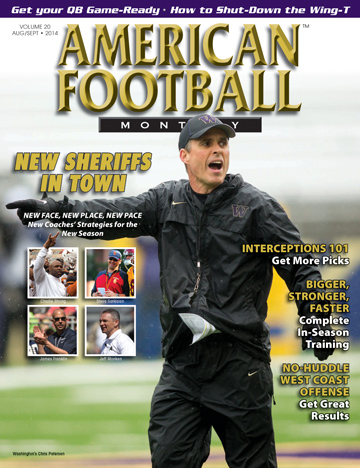The Art of the Interception Ė Proper positioning and anticipation are two prerequisites for making an interception.
by: JohnAllen W. SnyderOffensive Coordinator, Pequea Valley High School©
More from this issue
Just about every coach at every level will tell you that turnovers are critical. Interceptions, especially, alter the momentum and often change the outcome of a game. What can be done to help your defense cause an interception? What type of preparation is needed so that your defense is ready to anticipate a potential interception?
AFM spoke to five defensive coaches whose teams were among the leaders in interceptions last fall. They included four defensive coordinators: Josh Homolka Ė Ottawa University, Robert Wimberly Ė Liberty University, Chris Willis Ė the University of North Alabama, and Larry Harmon Ė the University of Mary Hardin-Baylor along with Cliff Collins, the defensive backs coach at East Mississippi Community College. They discussed the preparation, mindset and drills for being ready to force an interception.
What do you look for when analyzing your opponentís receivers?
Is part of it looking for tendencies they may have?
Homolka - We concentrate a lot on taking away route combinations. This changes from week to week depending on the team we are facing. We get very technical on how to break these combinations up. We talk to the defense about focusing on the #1 receiver. Our corners work on watching the reaction of the receiver and taking away the route when they break down. We also do a lot with down and distances. I talk to our guys all the time about putting the offense in a low percentage down and distance. When we can press based on the down and distance, we do. If itís a long situation, we will play back a bit and play the sticks.
Wimberly - We look at the concepts of the offensive team. What do they run? Are they a four vertical, high/low team? What are the splits of the receivers, and what is their stance for each pass play? Do they give anything away that we can use to help us?
Willis - We look at each receiver in a number of ways - outside vs. inside receivers and the differences between them both. We want to identify who the possession guy is, who the main targets are, and last, who is the deep threat guy. Our coaches take each receiver and watch every catch they make, the oneís they miss, and what they do when the ball is not thrown to them as well as how they perform on run downs. We check their splits from the end man on the line of scrimmage to determine if there is a tendency.
Does your strategy for pass coverage change based on down and distance?
Collins - Somewhat yes, but no matter the down and distance we want to disrupt the timing of the receiver. Our goal is to be aggressive, and get in the face of the receivers, press them up and make them go somewhere they donít want to go. If itís a situation such as third and long, we will back up and play the sticks. This gives us more freedom to react to the routes. We base everything out of a cover 2 look due to the types of teams we face week in and week out in our league (DIAGRAM 1).
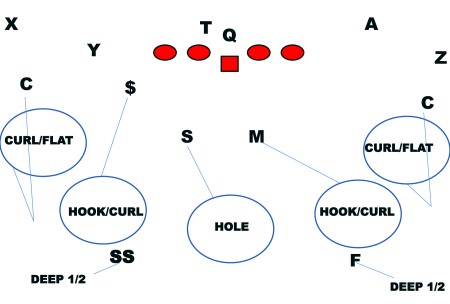
Diagram 1: Cover 2
We will play cover 2 press also. We want the cornerback to control the #1 outside receiver and see the QB. We teach making the zone turn here. It looks like cover 2 man coverage, but itís not. This allows our linebackers to play run first and pass second (DIAGRAM 2).
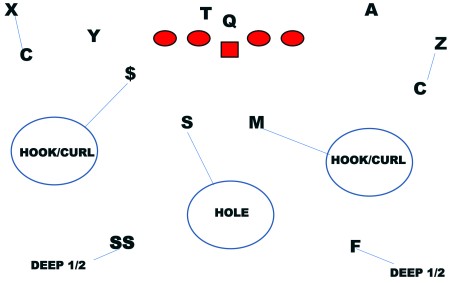
Diagram 2: Cover 2 Press
Homolka - Our strategy is based on our breakdowns of run vs. pass of the team we are facing. Most teams on first down are around 60% run and 40% pass. Our goal for first down is to keep them away from second and five or less. We want second and seven or worse. Our second down goal is to keep them above third and five. We feel this plays into our strength as a defense and puts pressure on the offense to come up with a play to beat us.
Harmon - We do change what coverage we are in based on down and distance. This is HUGE to us. If itís a run down, we like to get into man coverage and work some of our run pressures from the defensive line. This allows us to be much more physical at the corner position. Often in passing downs we are in a Tampa 2 defense giving us a zone look (DIAGRAM 3). Our philosophy is that we will give up seven or eight yards on third down if you need 10.
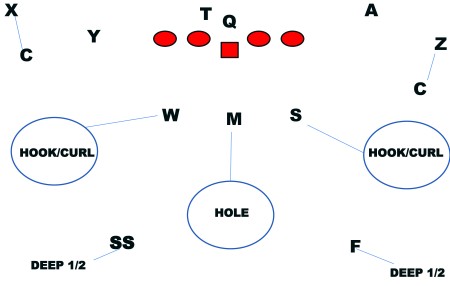
Diagram 3: Tampa 2 Coverage
What should your linebackers and defensive backs look for in pass coverage that may help for a potential interception?
Wimberly - For linebackers, we always talk about the split of the receivers from the end man on the line of scrimmage. They must know the routes and where the wide receivers are lined up. We educate our players on what they are going to see. Defensive back anticipation is very similar to the linebackers. Often the back seven players are in the same meetings and we do a lot of things together at practice to prepare for passing plays.
Willis - For linebackers, we look in our film sessions where the QBís eyes go to. Often they wonít look anyone off. That is a positive for us. We teach them to keep their eyes on a swivel and to get depth. For defensive backs, we have them ďthudĒ up in the skelly period. Thud is where the defense tackles the offensive player but does not take them to the ground. We also have them play the ball at all times. This has allowed us to keep up our aggressiveness.
Harmon - When we are in man coverage with our linebackers, we teach them to close the distance to the receiverís hip. Our goal is to shut down the inside cut or break and if they go outside, we want them to trail the hip and work to get in the passing lane. If we are in zone coverage, we focus on our drops. We DO NOT backpedal but want to pop our hips at a 45- degree angle and get depth to our zone.
We also talk about getting to our landmarks. Our linebackers are taught to break on the hand leaving the ball. With regard to defensive backs in man coverage, we again want to talk about their hips. I want our corners to control the receiver by getting to his hips and being physical. If he looks back for the ball, our defensive backs look back for the ball. We want our guys to keep inside leverage and force everything outside to the sideline using it as another defender. If we are in zone coverage, I want our corners to read run or pass first. From there we want them to keep their heads on a swivel as they drop.
What are the critical points for your defensive backs in covering a wide receiver?
Homolka - Iím an old linebacker so I was always taught to be aggressive to the point that we were at times over-aggressive. Over the years, certain players have taught me that we donít have to play that way. Patience can go a long way in gaining success out on the edge. Our defensive backs are taught to punch the bottom of the ribs. This keeps their eyes on the hips of the receiver and puts them in the best position to read and cover. We let our DBs read the receiver and let them make a decision on the best way to cover the offensive player.
Collins - We preach patience. Itís not easy because we also want to be aggressive. From a technical standpoint, we are interested in their stances being balanced and in control of their bodies. I talk a lot about having control over their feet and eyes. From there, we teach reacting and knowing, not thinking. We want to take the thought process out of it because we feel that slows the defense down.
Harmon - Stance, stance, stance. Itís so simple, yet so important. If your stance starts to break down, then everything after it will suffer. The next thing that is critical is your alignment. If we have poor leverage, we are opening ourselves up to everything they want to do to us. Finally, your eyes must be where they are supposed to be.
What are situations where your corner plays press coverage?
What are the factors that make press coverage effective?
Willis - We like to mix it up. I donít want to show our hand if we donít have to. We will show something pre-snap and then, on the snap, go to man or zone. Where we are on the field is a big indicator also. This allows us in situations to bring pressure up front and allows our corners to get physical. When we get into the red zone the offense becomes as constricted as the defense. But we see this as strength for the defense. We can play off man as opposed to press coverage (DIAGRAM 4).
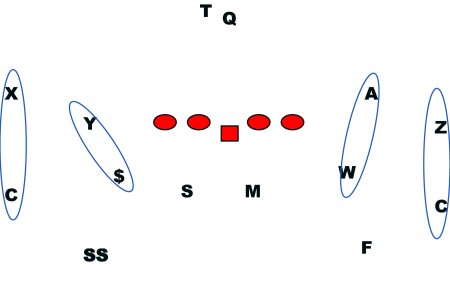
Diagram 4: Off Man Coverage
Collins - We want to take the outside receiver out of the game in the sense that we want him to be a non-factor. The corner can rally up to the flat once the safety comes over the top of the #1 receiver. In doing so, he will do what is called bracket coverage. This allows the corner to cover the outside, the safety to cover over the top, and our linebacker to cover the inside (DIAGRAM 5).
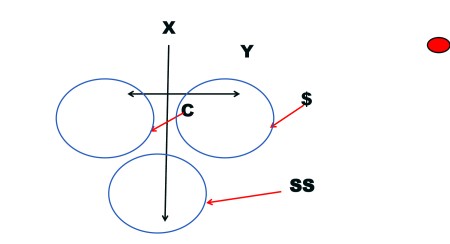
Diagram 5: Bracketing the Outside Receiver - Bracketing the Outside Receiver - the corner takes away the receiverís outside and the OLB takes away any inside cutting routes while the safety plays over the top taking away the deep ball.
Homolka - We look at everything as down and distance as well as personnel groupings. These are great keys to factor in when considering a run or pass. When talking about down and distance, there are many quarterbacks that come out on first down and throw a 3-step quick passing game. This is a situation where we will press them. If we get in a long distance down, then we will back off a bit.
What types of risks do you let your defensive backfield take?
Wimberly - I like to let them have freedom, but to do that they must buy into what we want to do overall defensively. We allow them to show anything as long as you they know what they need to do when the ball is snapped. Our players have to understand the game. We want to let them have ownership of the game and have fun with the overall process of preparing each week.
Harmon - I donít like to paralyze them with absolute MUSTS and RULES. If they see something and can make a play, go and do it. We must trust that they will get in the right position. With younger corners, itís hard because you donít trust them as much and they have to earn that trust.
Homolka - In our defense, we do a boundary/field setup. Here we take our best tackler (safety) and corner and put them to the field to stop the peak and the bubble plays. On the flip side, we want our best cover corner to the boundary side. We like to think of our players as very cognitive players in that they go into a game knowing where the opponent lines up vs. different formations and personnel groupings. This also goes for down and distance. This takes a lot of the risks away from our players.
Do you have a favorite interception drill?
Willis - We donít necessarily have a favorite team interception drill, but we do have two drills that simulate the ball being thrown and we have to work to get into the right position. The first is one of my favorite drills and it teaches the defender to come from behind and play the ball, not the receiver. As always, there is a ball involved and the defender must make the interception in order to complete the drill successfully (DIAGRAM 6A).
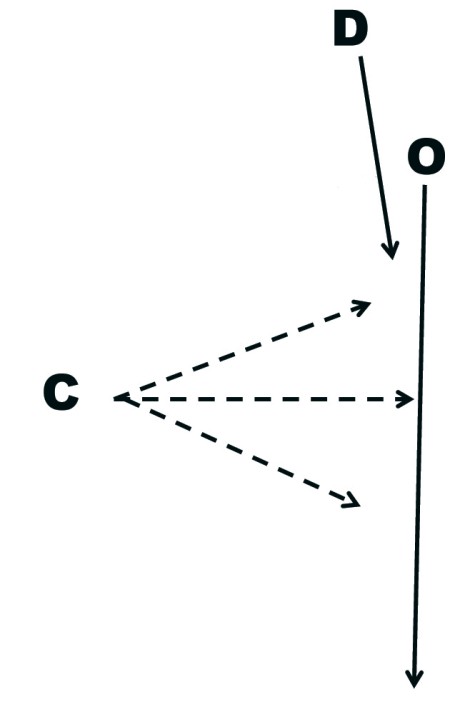
Diagram 6A: Take Over Drill - Take Over Drill - the defender trails behind the offensive player. At different points, the coach throws the ball. The defender tries to make a play on the ball and go for the interception.
The next drill we do is called a Trail Drill. This drill finds the defender on the hip of the offensive player in a man situation. The coach throws the ball up at different points in the route and the defender must read the offensive player and turn and make a play on the ball (DIAGRAM 6B).
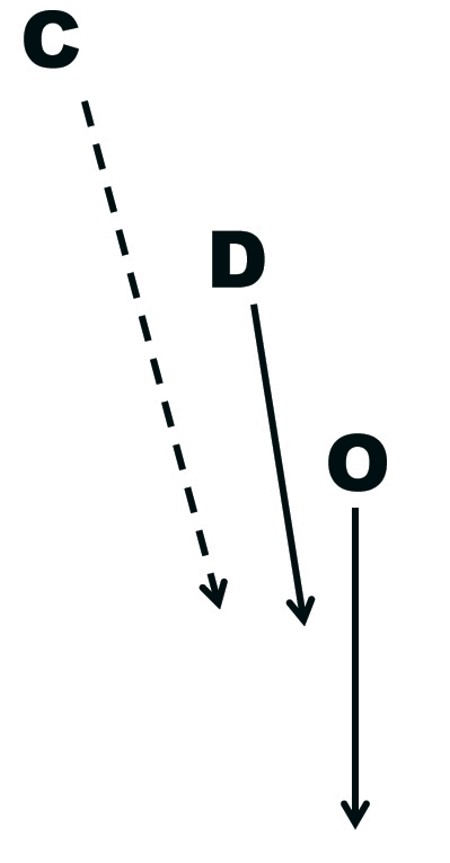
Diagram 6B: Trail Drill - The defender again trails the offensive player. He is focused on staying on the WRís hip and reading the hip and eyes. The ball is thrown and the defender must adjust based on the WRís eyes and then turn and make a play on the ball.
Wimberly - We are all about having fun and doing drills that emphasize the football. By that I mean we want to change the monotony of practice with drills that allow the players to play free and loose while working on fundamentals of the pass defense. We are a big circuit team and all of our circuits involve the football. These are done every day so that our skills remain consistent.
Harmon - In our defense, literally every person has the opportunity to drop and get an interception - even the defensive linemen. We incorporate this into our daily MUSTS. We are a big circuit team, not only with turnovers and tackling circuits but also with different pass themes. One station may be defending the fade and another may be in a man situation for out routes/out and ups.
Collins - We donít necessarily have a favorite interception drill but we do a ton of work within our own individual drills. I talk to my guys about three things with regard to the ball. First, see the route and catch the ball. If they can do that, then we are fundamentally sound in our game. Second, to be great you have to have great ball skills. Here I want my players touching the ball as often as possible. I want us around it all the time. Finally, I tell them that they will catch more balls in a given practice than the wide receivers do. And this is why in each drill we do there is a ball and catch element to it.
